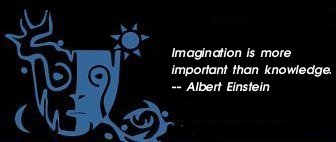|

Selections from Thou Art That, Transforming Religious Metaphor
by Joseph Campbell
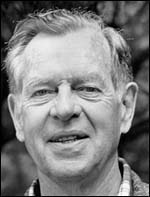 Joseph
Campbell (1904 - 1987) was an American author and teacher best known
for his work in the field of comparative mythology. Campbell was educated at
Columbia University, where he specialized in medieval literature. His first
original work, The Hero with a Thousand Faces, was published in 1949 and
was immediately well received; in time, it became acclaimed as a classic. In
this study of the "myth of the hero," Campbell asserted that there is a single
pattern of heroic journey and that all cultures share this essential pattern in
their various heroic myths. This theme of essential universality pervades all
of Campbell's work and he offers it as the context in which new mythologies may
be born which will spiritually unite mankind. Joseph
Campbell (1904 - 1987) was an American author and teacher best known
for his work in the field of comparative mythology. Campbell was educated at
Columbia University, where he specialized in medieval literature. His first
original work, The Hero with a Thousand Faces, was published in 1949 and
was immediately well received; in time, it became acclaimed as a classic. In
this study of the "myth of the hero," Campbell asserted that there is a single
pattern of heroic journey and that all cultures share this essential pattern in
their various heroic myths. This theme of essential universality pervades all
of Campbell's work and he offers it as the context in which new mythologies may
be born which will spiritually unite mankind.
This copyrighted material is reproduced with the written permission of the
Joseph Campbell Foundation
. The Joseph Campbell Foundation is a partner of the Mythic Imagination
Institute, and the Foundation's President, Robert Walter, is a presenter at
Mythic Journeys 06.
 Editor's Note: Thou Art That is a volume
from The Collected Works of Joseph Campbell and includes material from writings
and lectures unpublished at the time of Campbell's death in 1987. The title, Thou
Art That, is a phrase Campbell uses often throughout this volume and is
a translation of the Sanskrit phrase, Tat tvam asi
. Editor's Note: Thou Art That is a volume
from The Collected Works of Joseph Campbell and includes material from writings
and lectures unpublished at the time of Campbell's death in 1987. The title, Thou
Art That, is a phrase Campbell uses often throughout this volume and is
a translation of the Sanskrit phrase, Tat tvam asi
.
This first selection is from Chapter 3, "Our Notions of God," and is titled
"Symbols: Out of Time and Place" in which Joseph Campbell discusses the
Arthurian legend and the Queste del Saint Graal, pages 28 - 31.
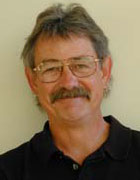 
Robert
Walter is Executive Director of the Joseph Campbell Foundation,
a position he has held since its inception in 1990. In 1979, Bob began to work
on several projects with Joseph Campbell, who subsequently named him editorial
director of his Historical Atlas of World Mythology. Following
Campbell's death in 1987, he served as literary executor of Campbell's estate,
completing Volumes I and II of the Atlas and supervising its posthumous
publication. He continues to oversee the publication of Campbell's oeuvre,
including the video series Joseph Campbell's Mythos and the Joseph
Campbell Audio Collection. Prior to his work in publishing, Bob was a founding
Faculty Fellow at California Institute of the Arts; lectured widely on
experiential education; and pursued a professional theater career, working for
a decade as a director, production manager, and playwright. Bob was a founding
Trustee of United Religions Initiative (URI) and has served that organization
as Treasurer and as a member of its Global Council.
Symbols: Out of Time and Place
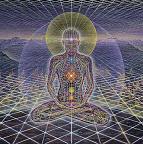 "History
is not, as we well know, the actual source or primary reference of these
symbols. They are psychological archetypes known to all
mythologies. That is why, at this time, the gurus and the roshis from India and
Japan are having such a profound influence and exerting such attraction on
Westerners, particularly young people. They are telling our flocks that the
reference of these universal symbols lies within themselves. The Western
institutions should understand that they are right and recall that they possess
the very same symbols on the altars of their churches. We Westerners also have
the same spiritual lessons in the words of many of our own greatest mystics. "History
is not, as we well know, the actual source or primary reference of these
symbols. They are psychological archetypes known to all
mythologies. That is why, at this time, the gurus and the roshis from India and
Japan are having such a profound influence and exerting such attraction on
Westerners, particularly young people. They are telling our flocks that the
reference of these universal symbols lies within themselves. The Western
institutions should understand that they are right and recall that they possess
the very same symbols on the altars of their churches. We Westerners also have
the same spiritual lessons in the words of many of our own greatest mystics.
"To which thought I would now add another, that when you are given a dogma
telling precisely what kind of meaning you shall experience in a symbol,
explaining what kind of effect it should have upon you, then you are in
trouble. This symbol may not have the same meaning for you that it had for a
council of Levantine bishops in the fourth century. If you do not react as
expected, you doubt your faith. The real function of a church is simply to
preserve and present symbols and to perform rites, letting believers experience
the message for themselves in whatever way they can. Whatever the relationship
of the Father to the Son, or of the Father and Son to the Holy Ghost may be, as
defined by high ecclesiastical authority, the individual's assent to a
definition is not nearly as important as his or her having a spiritual
experience by virtue of the influence of the symbol. To respond, for example,
to the Virgin Birth within one's heart by a birth of the spiritual life that we
know as 'of Christ.' This Virgin Birth within is well expressed in Saint Paul's
statement, 'I live, now not I, but Christ liveth in me' (Gal. 2:20).
"We are all born as animals and live the life that animals live: we sleep, eat,
reproduce, and fight. There is, however, another order of living, which the
animals do not know, that of awe before the mystery of being, the mysterium
tremendum et fascinans
, that can be the root and branch of the spiritual sense of one's days. That is
the birth - the Virgin Birth - in the heart of a properly human, spiritual
life.
"As the mystic Meister Eckhart declared of such a crisis in a sermon to his
congregation ('Sermons and Collations' LXXXXVIII), "It is more worth to God his
being brought forth ghostly in the individual virgin or good soul than that he
was born of Mary bodily.' To which he added, 'This involves the notion of our
being the only Son whom the Father has eternally begotten ... The best God ever
did for Man was to be man himself.' Reading the symbol this way sheds the dross
of history for the immediacy of our experience of mystery.
 "Just think of it! We have come forth from this Earth of ours. And the Earth
itself came of a galaxy, which, in turn, was a condensation of atoms gathered
in from space. The Earth may be regarded as a precipitation of space. Is it any
wonder, then, that the laws of that space are ingrained in our minds? The
philosopher Alan Watts once said, 'The earth is peopling, as apple trees
"apple." People are produced from the earth as apples from apple trees.' We are
the sensing organs of the Earth. We are the senses of the universe. We have it
all right here within us. And the deities that we once thought were out there,
we now know, were projected out of ourselves. They are the products of our
human imagination seeking to interpret, one way or another, the mysteries of
the universe, which we surely see today as a very different universe from what
it was in the days when Yahweh threw down stones from heaven on the army of the
Amorites and caused the sun to stand still in the sky until his chosen nation
took vengeance on its enemies (Joshua 10:13).
"Just think of it! We have come forth from this Earth of ours. And the Earth
itself came of a galaxy, which, in turn, was a condensation of atoms gathered
in from space. The Earth may be regarded as a precipitation of space. Is it any
wonder, then, that the laws of that space are ingrained in our minds? The
philosopher Alan Watts once said, 'The earth is peopling, as apple trees
"apple." People are produced from the earth as apples from apple trees.' We are
the sensing organs of the Earth. We are the senses of the universe. We have it
all right here within us. And the deities that we once thought were out there,
we now know, were projected out of ourselves. They are the products of our
human imagination seeking to interpret, one way or another, the mysteries of
the universe, which we surely see today as a very different universe from what
it was in the days when Yahweh threw down stones from heaven on the army of the
Amorites and caused the sun to stand still in the sky until his chosen nation
took vengeance on its enemies (Joshua 10:13).
"Nor is our society what the ancient once was. The laws of social life today
change from minute to minute. There is no more security in the knowledge of
some communicated moral law. One must search out one's own values and assume
responsibility for one's own order of action and not simply follow orders
handed down from some period past. Moreover, we are intensely aware of
ourselves as individuals, each responsible in his or her own way, to themselves
and to their world.
"We can no longer speak of 'outsiders.' It once was possible for the ancients to
say, 'We are the chosen of God!' and to save all love and respect for
themselves, projecting their malice 'out there.' That today is suicide. We have
now to learn somehow to quench our hate and disdain through the operation of an
actual love, not a mere verbalization, but an actual experience
of compassionate love, and with that fructify, simultaneously, both our
neighbor's life and our own.
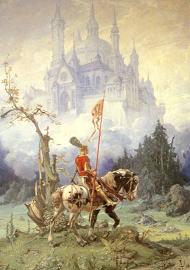 "There
is a passage in the Old French Queste del Saint Graal
that epitomizes the true spirit of Western man. It tells of a day when the
knights of Arthur's court gathered in the banquet hall waiting for dinner to be
served. It was a custom of that court that no meal should be served until an
adventure had come to pass. Adventures came to pass in those days frequently so
there was no danger of Arthur's people going hungry. On the present occasion
the Grail appeared, covered with a samite cloth, hung in the air a moment, and
withdrew. Everyone was exalted, and Gawain, the nephew of King Arthur, rose and
suggested a vow. 'I propose,' he said, 'that we all now set forth in quest to
behold that Grail unveiled.' And so it was that they agreed. There then comes a
line that, when I read it, burned itself into my mind. 'They thought it would
be a disgrace to go forth in a group. Each entered the forest at the point that
he himself had chosen, where it was darkest, and there was no way or path.' "There
is a passage in the Old French Queste del Saint Graal
that epitomizes the true spirit of Western man. It tells of a day when the
knights of Arthur's court gathered in the banquet hall waiting for dinner to be
served. It was a custom of that court that no meal should be served until an
adventure had come to pass. Adventures came to pass in those days frequently so
there was no danger of Arthur's people going hungry. On the present occasion
the Grail appeared, covered with a samite cloth, hung in the air a moment, and
withdrew. Everyone was exalted, and Gawain, the nephew of King Arthur, rose and
suggested a vow. 'I propose,' he said, 'that we all now set forth in quest to
behold that Grail unveiled.' And so it was that they agreed. There then comes a
line that, when I read it, burned itself into my mind. 'They thought it would
be a disgrace to go forth in a group. Each entered the forest at the point that
he himself had chosen, where it was darkest, and there was no way or path.'
"No way or path! Because where there is a way or path, it is someone else's
path. And that is what marks the Western spirit distinctly from the Eastern.
Oriental gurus accept responsibility for their disciples' lives. They have an
interesting term, 'delegated free will.' The guru tells you where you are on
the path, who you are, what to do now, and what to do next.
"The romantic quality of the West, on the other hand, derives from an
unprecedented yearning, a yearning for something that has never yet been seen
in this world. What can it be that has never yet been seen? What has never yet
been seen is your own unprecedented life fulfilled. Your life is what has yet
to be brought into being.
"In this modern world of ours, in which all things, all institutions, seem to be
going rapidly to pieces, there is no meaning in the group, where all meaning
was once found. The group today is but a matrix for the production of
individuals. All meaning is found in the individual, and in each one this
meaning is considered unique. And yet, let us think, in conclusion about this:
when you've lived your individual life in your own adventurous way and then
look back upon its course, you will find that you have lived a model human
life, after all."
Editor's Note:
The second selection is from pages 87 - 89, in the chapter titled "Question
Period." In his answers to questions, Joseph Campbell adds an even more direct
discussion of the "quest" and "the hero's journey." Following are excerpts:
"Question:
Does the mythic motif of the 'Hero's Journey' apply to the Judeo - Christian
tradition?
"Let us review some of the basic mythological heroes who work through for us
the crisis of resolution by which the classical mythological cycle is
completed.
 "We begin with Moses, the symbol of one who goes off alone, leaving his people
only to return with a law for them. This is the identical hero journey that we
find in all of the old ethnic traditions. Every one of the social orders is
finally traced back to the realization and experience of some single individual
who alone experiences the mystery, passes the test, as it were, and returns
with a message for mankind, as in the case of Moses, his coming down from the
mountain with the Ten Commandments.
"We begin with Moses, the symbol of one who goes off alone, leaving his people
only to return with a law for them. This is the identical hero journey that we
find in all of the old ethnic traditions. Every one of the social orders is
finally traced back to the realization and experience of some single individual
who alone experiences the mystery, passes the test, as it were, and returns
with a message for mankind, as in the case of Moses, his coming down from the
mountain with the Ten Commandments.
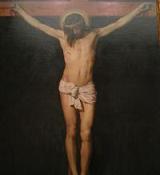 "The next great figure in this tradition is Christ. How was Christ understood
by the original Christians, all of whom were Jews? The key word is found in
Paul who wrote to the Galatians that Christ redeemed man from the curse of the
Law. The 'Establishment' may be understood as a system of laws through which
one's experiences of life are filtered. One must be redeemed from this through
the doctrine of love. From Christ's words, we have learned that we should love
our neighbors. We are not - as in previous times - to hate our enemies, but to
love them instead. Christ also said that man is not made for the Sabbath, but
that the Sabbath is made for man. In other words, the Law is to serve man and
not man the Law. This represents an enormous transformation of our spiritual
understanding of our relationship to each other, God, and laws fashioned by
other men in His Name.
"The next great figure in this tradition is Christ. How was Christ understood
by the original Christians, all of whom were Jews? The key word is found in
Paul who wrote to the Galatians that Christ redeemed man from the curse of the
Law. The 'Establishment' may be understood as a system of laws through which
one's experiences of life are filtered. One must be redeemed from this through
the doctrine of love. From Christ's words, we have learned that we should love
our neighbors. We are not - as in previous times - to hate our enemies, but to
love them instead. Christ also said that man is not made for the Sabbath, but
that the Sabbath is made for man. In other words, the Law is to serve man and
not man the Law. This represents an enormous transformation of our spiritual
understanding of our relationship to each other, God, and laws fashioned by
other men in His Name.
"Let me remind you of that moment in which Christ transcended all the laws. It
is the story of His forty days in the desert. In this case, the devil
represented the Law that had to be transcended. The very first question the
Devil put to Christ was, 'Why don't you turn these stones into bread?' Christ
replies that man lives not by bread alone but by every word that comes from the
mouth of God. He rejects the economic theory of the spiritual life, thereby
refuting Bernard Shaw's notion that one must be economically well - off before
one can practice spiritual exercises.
"In the second temptation, the Devil takes Christ up onto the mountain top,
showing and offering to Him the lands of the world if He will bow down to him.
And Christ says, 'Get thee behind me, Satan,' thereby transcending the
seduction of political power as life's aim.
"The Devil then takes Him up to the pinnacle of the temple, suggesting that if
Christ is so spiritual, He can cast Himself down and God will bear Him up.
Christ rejects this temptation to spiritual inflation by saying, 'You shall not
tempt the Lord thy God.' Christ returns then from the desert to preach to the
people the new message of the spirit, the message of love.
"Question:
Does this apply to us? Are we 'heroes' on a spiritual journey?
"In the European Middle Ages the theme of an individual on an individual quest
clearly emerges. This is the theme of the Grail legends. Why should anyone go
questing for the Grail in Gothic Europe when the Holy Sacrifice of the Mass was
being celebrated in every church? The reason was that the Holy Sacrifice of the
Mass was a general sacrament that did not depend on the recipient's or the
priest's personal character for its effect. It was a miraculous, magically
working conduit of the grace of the Crucifixion of Christ which pours into
those who received it. All one had to do was abide by the laws of the Church
and examine one's conscience and resolve not to sin again. It was not in
itself, however, a test of character.
"This mythological Grail was not inside any Church and only the person who had
a certain character could find it. The Grail was carried by absolutely virtuous
maidens and it represented an integrity of character and life rather than a
sacramental system.
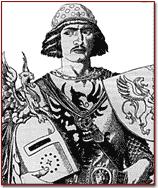 "Sir
Gawain, Arthur's nephew, proposes a vow, since they thought it a disgrace to go
forth in a group, each should enter the forest at that point where he found it
darkest, and where no other path existed. This is the absolute opposite to the
Oriental guru system, in which you accept the direction of a guru who knows
what is best for you. But it is you and your potential character, which has
never been seen and which can be brought into being by no one else, that is the
life quest in the Western sense. Each individual pursues it in his or her own
way. The problem in our society and in our schools is to inculcate, without
overdoing it, the notion of education, as in the Latin educere - to
lead, to bring out what is in someone rather than merely to indoctrinate
him/her from the outside. Spiritually, then, we must all seek the Grail by
entering that part of the forest where nobody else has cut a path for us." "Sir
Gawain, Arthur's nephew, proposes a vow, since they thought it a disgrace to go
forth in a group, each should enter the forest at that point where he found it
darkest, and where no other path existed. This is the absolute opposite to the
Oriental guru system, in which you accept the direction of a guru who knows
what is best for you. But it is you and your potential character, which has
never been seen and which can be brought into being by no one else, that is the
life quest in the Western sense. Each individual pursues it in his or her own
way. The problem in our society and in our schools is to inculcate, without
overdoing it, the notion of education, as in the Latin educere - to
lead, to bring out what is in someone rather than merely to indoctrinate
him/her from the outside. Spiritually, then, we must all seek the Grail by
entering that part of the forest where nobody else has cut a path for us."
Return to Passages
Menu
Subscribe to the Passages
e-zine
|
